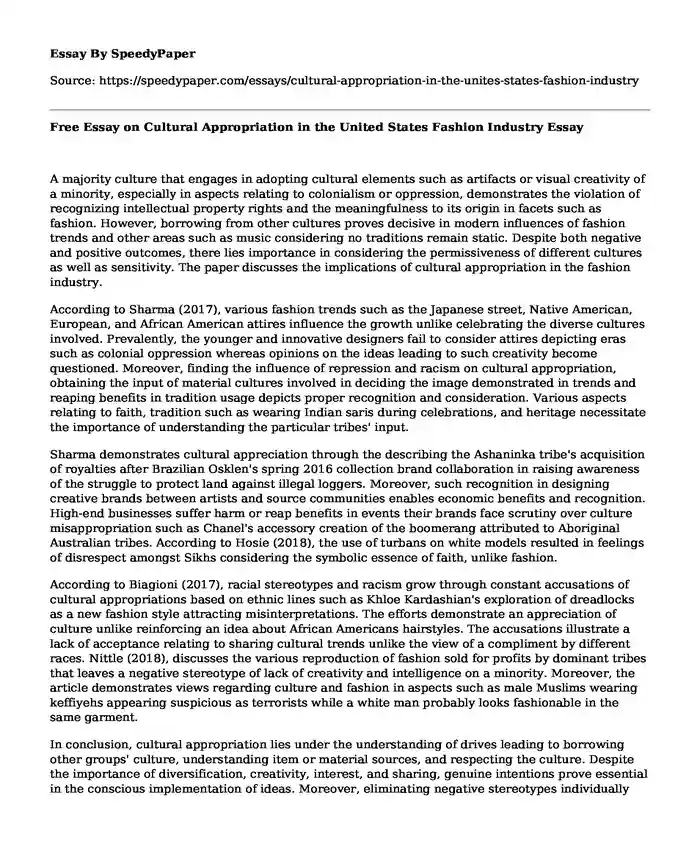A majority culture that engages in adopting cultural elements such as artifacts or visual creativity of a minority, especially in aspects relating to colonialism or oppression, demonstrates the violation of recognizing intellectual property rights and the meaningfulness to its origin in facets such as fashion. However, borrowing from other cultures proves decisive in modern influences of fashion trends and other areas such as music considering no traditions remain static. Despite both negative and positive outcomes, there lies importance in considering the permissiveness of different cultures as well as sensitivity. The paper discusses the implications of cultural appropriation in the fashion industry.
According to Sharma (2017), various fashion trends such as the Japanese street, Native American, European, and African American attires influence the growth unlike celebrating the diverse cultures involved. Prevalently, the younger and innovative designers fail to consider attires depicting eras such as colonial oppression whereas opinions on the ideas leading to such creativity become questioned. Moreover, finding the influence of repression and racism on cultural appropriation, obtaining the input of material cultures involved in deciding the image demonstrated in trends and reaping benefits in tradition usage depicts proper recognition and consideration. Various aspects relating to faith, tradition such as wearing Indian saris during celebrations, and heritage necessitate the importance of understanding the particular tribes' input.
Sharma demonstrates cultural appreciation through the describing the Ashaninka tribe's acquisition of royalties after Brazilian Osklen's spring 2016 collection brand collaboration in raising awareness of the struggle to protect land against illegal loggers. Moreover, such recognition in designing creative brands between artists and source communities enables economic benefits and recognition. High-end businesses suffer harm or reap benefits in events their brands face scrutiny over culture misappropriation such as Chanel's accessory creation of the boomerang attributed to Aboriginal Australian tribes. According to Hosie (2018), the use of turbans on white models resulted in feelings of disrespect amongst Sikhs considering the symbolic essence of faith, unlike fashion.
According to Biagioni (2017), racial stereotypes and racism grow through constant accusations of cultural appropriations based on ethnic lines such as Khloe Kardashian's exploration of dreadlocks as a new fashion style attracting misinterpretations. The efforts demonstrate an appreciation of culture unlike reinforcing an idea about African Americans hairstyles. The accusations illustrate a lack of acceptance relating to sharing cultural trends unlike the view of a compliment by different races. Nittle (2018), discusses the various reproduction of fashion sold for profits by dominant tribes that leaves a negative stereotype of lack of creativity and intelligence on a minority. Moreover, the article demonstrates views regarding culture and fashion in aspects such as male Muslims wearing keffiyehs appearing suspicious as terrorists while a white man probably looks fashionable in the same garment.
In conclusion, cultural appropriation lies under the understanding of drives leading to borrowing other groups' culture, understanding item or material sources, and respecting the culture. Despite the importance of diversification, creativity, interest, and sharing, genuine intentions prove essential in the conscious implementation of ideas. Moreover, eliminating negative stereotypes individually especially among influential people proves a fundamental concept in demonstrating the appreciation of other cultures and disengagement in oppressive systems. The paper ascertains the importance of cultural recognition unlike appropriation in the fashion industry in the U.S as well as across the world.
References
Biagioni., S.,M (2017). Cultural Appropriation Reinforces Racial Stereotypes. Retrieved from: https://www.theodysseyonline.com/cultural-appropriation-reinforces-racial-stereotypes. Accessed on 20th July 2018.
Hosie, R (2018). CULTURAL APPROPRIATION: WHEN DOES APPRECIATION CROSS THE LINE? Retrieved from: https://www.independent.co.uk/life-style/fashion/cultural-appropriation-appreciation-difference-meaning-fashion-examples-chinese-prom-dress-a8332176.html. Accessed on 20th July 2018.
Nettle., K., N (2018). A Guide to Understanding and Avoiding Cultural Appropriation. Retrieved from: https://www.thoughtco.com/cultural-appropriation-and-why-iits-wrong-2834561. Accessed on 20th July 2018.
Sharma, J (2017). When does cultural inspiration become appropriation in the fashion world? Retrieved from: https://www.scmp.com/magazines/style/fashion-beauty/article/2118609/when-does-cultural-inspiration-become-appropriation. Accessed on 20th July 2018.
Cite this page
Free Essay on Cultural Appropriation in the United States Fashion Industry. (2022, Jul 04). Retrieved from https://speedypaper.com/essays/cultural-appropriation-in-the-unites-states-fashion-industry
Request Removal
If you are the original author of this essay and no longer wish to have it published on the SpeedyPaper website, please click below to request its removal:
- Borderline Personality Disorder Essay Sample
- The Alabama Music Hall of Fame - Business Description Essay Sample
- Finance Essay Sample for Free: Evaluate Pay Equity
- Free Essay about Egyptian National Cinema
- Essay Example on Global Warming Case Study of Australia
- Free Essay Example on Du Bois' The Souls of Black Folk
- Essay Sample on Teamwork and Collaboration for Patients With Diabetes
Popular categories





